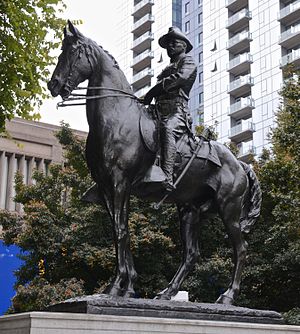Theodore Roosevelt, Rough Rider
| Theodore Roosevelt, Rough Rider | |
|---|---|

The sculpture in 2016
|
|
|
Location in Portland, Oregon
|
|
| Artist | Alexander Phimister Proctor |
| Year | 1922 |
| Type | Sculpture |
| Medium | Bronze |
| Subject | Theodore Roosevelt |
| Dimensions | 3.7 m × 0.91 m × 2.7 m (12 ft × 3 ft × 9 ft) |
| Condition | "Treatment needed" (1993) |
| Location | Portland, Oregon, United States |
| 45°30′58″N 122°40′58″W / 45.516030°N 122.682854°WCoordinates: 45°30′58″N 122°40′58″W / 45.516030°N 122.682854°W | |
Theodore Roosevelt, Rough Rider is an outdoor bronze sculpture by American artist Alexander Phimister Proctor, located in the South Park Blocks of Portland, Oregon in the United States. The equestrian statue was completed in 1922 and depicts Theodore Roosevelt as the leader of the cavalry regiment that fought during the Spanish–American War called the Rough Riders.
Theodore Roosevelt, Rough Rider is an equestrian statue designed by American sculptor Alexander Phimister Proctor (1860–1950). The bronze sculpture depicts Theodore Roosevelt, former President of the United States, as the leader of the cavalry regiment called the Rough Riders, who fought during the Spanish–American War. According to the Regional Arts & Culture Council, which administers the work, "Proctor took great care in accurately depicting Roosevelt as a symbol of American determination, success, and strength and as a bridge back to the Wild West." The statue is located in Portland's South Park Blocks, along Southwest Park Avenue between Southwest Jefferson and Madison Streets. It measures 12 feet (3.7 m) × 3 feet (0.91 m) × 9 feet (2.7 m) and is mounted to a base that measures 7 feet 8 inches (2.34 m) long × 6 feet (1.8 m) high × 1 foot 6 inches (0.46 m) wide.
The memorial was commissioned after Roosevelt's death. Completed in 1922, the sculpture was cast in Brooklyn, New York and was shipped by sea via the Panama Canal to avoid cutting the work into pieces. Henry Waldo Coe, a friend and hunting partner of Roosevelt's, donated the statue to the City of Portland. Calvin Coolidge, then Vice President of the United States, was present at the statue's dedication.
...
Wikipedia

